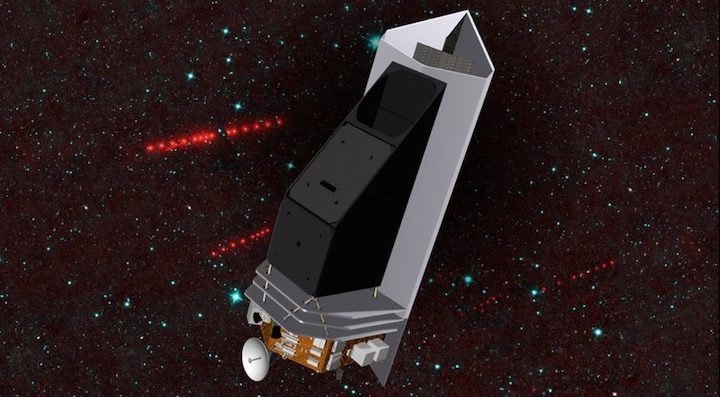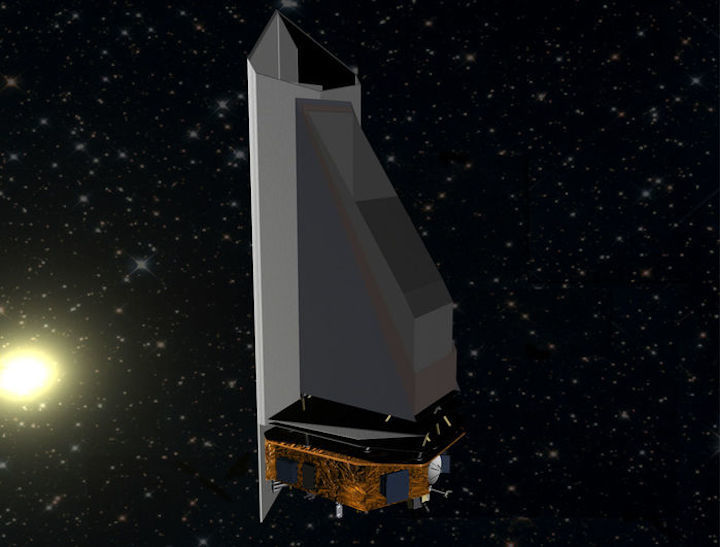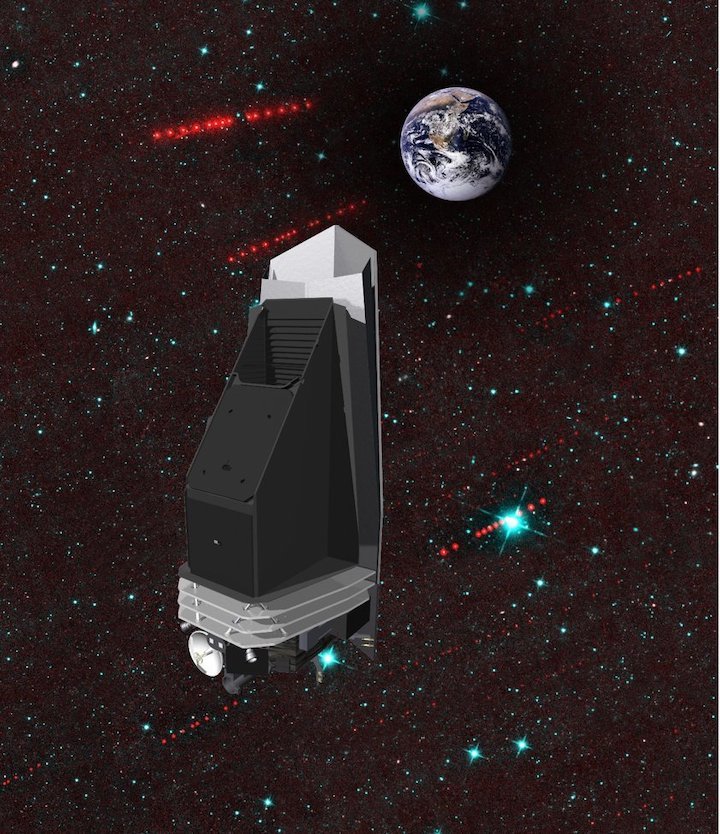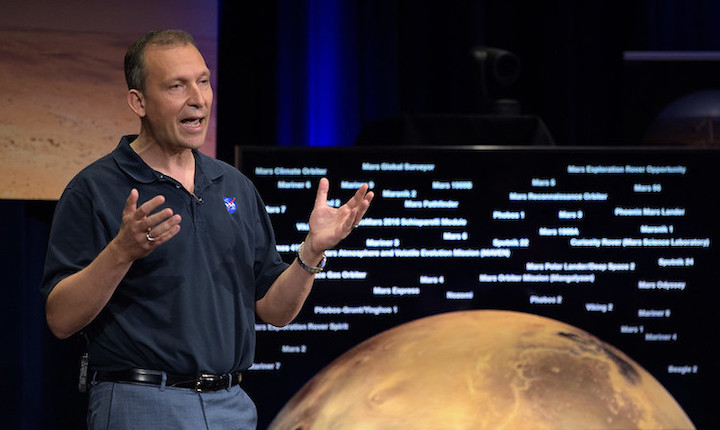24.09.2019

KAHULUI, Hawaii — After years of study and failed proposals, NASA has decided to proceed with development of a space-based telescope to search for near-Earth asteroids.
Thomas Zurbuchen, NASA’s associate administrator for science, said Sept. 23 the agency will go forward with a mission called the Near-Earth Object (NEO) Surveillance Mission, a concept based on the NEOCam mission that was a finalist in the previous competition for Discovery-class planetary science missions.
A key difference for NEO Surveillance Mission, though, is that the mission will be “directed” by NASA, rather than competed through the Discovery or another program. The Jet Propulsion Laboratory will lead development of the mission under NASA’s planetary defense program.
Zurbuchen, speaking at a meeting of the agency’s Planetary Science Advisory Committee in Washington, said that the mission is more of an operational one, designed to meet a congressional goal of discovering at least 90 percent of the near-Earth asteroids at least 140 meters in diameter, rather than a science mission following the direction of decadal surveys.
“The only reason we want every 140-meter object is not because we need it to do all the science,” he said. “It’s because we want to understand whether one of them is on a collision course over time to Earth.”
Zurbuchen said that the new mission, strictly speaking, would not be a continuation of NEOCam. That mission, proposed in the previous Discovery competition, was one of the finalists, but not selected for flight in early 2017. NASA, though, did provide extended Phase A funding to support work on the infrared detectors the mission would use to search for asteroids.
“NEOCam was a [principal investigator]-class mission that was not selected, put into an extended Phase A, and then stopped,” he said. “The thing we invested time in is the instrument, that is going forward as part of a mission that has a lot of similarities to what NEOCam was conceived.”
The new mission, as described at the meeting, would fly a 50-centimeter telescope with a camera that operates in the infrared between 4 and 10 microns. The spacecraft would have a total mass of no more than 1,300 kilograms, allowing it to launch on a vehicle like an Atlas 5 or Falcon 9 to the Earth-sun L-1 Lagrange point. Once in space, Zurbuchen said the mission should reach the 90% congressional goal within 10 years, with an ticipated mission lifetime of 12 years.
The total cost of the NEO Surveillance Mission would be $500–600 million, with a launch no earlier than fiscal year 2025. The mission’s funding would come from the agency’s planetary defense program, currently funded at $150 million a year and finishing work on the Double Asteroid Redirection Test (DART) mission for launch in 2021.
That approach appears to be along the lines of what many in the planetary defense community were looking for. In recent months, they had argued for using the planetary defense budget to support a series of missions, including a NEOCam-like observatory and others to study specific near Earth objects.
The decision to proceed with the new mission raised questions at the meeting about what would happen to the team that worked on NEOCam, including principal investigator (PI) Amy Mainzer, who recently moved from JPL to the University of Arizona. “I expect the former PI of NEOCam to have a really crucial role,” Zurbuchen said, but added he didn’t plan to prescribe a decision on that role.
“We’re working it out,” Mainzer, in attendance at the meeting, said.
The core NEOCam science team will also likely be involved in the new mission, said Lindley Johnson, head of NASA’s Planetary Defense Coordination Office. However, he said there may be calls for additional participating scientists for the mission.
Quelle: SN
+++
NASA to build telescope for detecting asteroids that threaten Earth

NASA is proposing to move ahead with a telescope that would spot asteroids on a potential collision course with Earth. It is based on this proposed project, the Near-Earth Object Camera.
NASA/JPL-CALTECH
NASA is moving forward with plans to launch an infrared telescope that could detect asteroids on a collision course with Earth. Its launch could come by the middle of the next decade, Thomas Zurbuchen, NASA’s associate administrator for science in Washington, D.C., said today at a meeting of an agency advisory panel.
The Near-Earth Object Surveillance Mission, which will cost $500 million to $600 million, grows out of long-gestating plans for the Near-Earth Object Camera (NEOCam), first proposed by NASA’s Jet Propulsion Lab (JPL) in Pasadena, California, nearly 15 years ago. Such a scope is essential for meeting a congressional requirement that NASA detect 90% of all potentially hazardous asteroids and comets of at least 140 meters in diameter by the end of 2020. The telescope will likely end up with a different name, but the mission is the same, says Mark Sykes, CEO of the Planetary Science Institute in Tucson, Arizona, and a member of NEOCam’s science team. “There is no independent or new spacecraft or operational design here. This mission is NEOCam.”
Although NASA will not meet Congress’s deadline—which wasn’t attached to any funding—a combination of an infrared telescope and the Large Synoptic Survey Telescope, a ground-based facility being built in Chile, will eventually make it a reality, the National Academies of of Sciences, Engineering, and Medicine in Washington, D.C., said this summer in a report. A telescope operating in the infrared spectrum is essential, researchers say, as the past decade has shown that dark asteroids, which are nearly invisible in visible light but stand out in infrared, are more abundant than once thought. “There are a lot of really dark asteroids out there,” says Jay Melosh, a planetary scientist at Purdue University in West Lafayette, Indiana, and an author of the report. “That pushes the need for the infrared system.”
Building the infrared telescope, however, could require an increase in NASA’s $150 million annual budget for planetary defense. Most of that money now goes to the Double Asteroid Redirection Test (DART) mission being built by Johns Hopkins University’s Applied Physics Laboratory in Laurel, Maryland. Set for launch in 2021, DART seeks to test whether it’s possible to deflect the path of an asteroid. It’s unclear whether congressional appropriators will follow NASA’s lead and also fund the new infrared telescope.
The mission also marks perhaps the first time that NASA has taken a mission proposal developed by an outside group for one its competitive science programs and proposed running it internally, Sykes says. The move could recast the role of Amy Mainzer, an astronomer at the University of Arizona in Tucson who has led NEOCam since it was first proposed, and her science team. Mainzer, who recently moved from JPL to the university’s Lunar and Planetary Laboratory, would have served as the mission’s principal investigator.
“I’m hearing [today’s news] at the same time as everyone else,” says Mainzer, who serves on NASA’s Planetary Science Advisory Committee, which is meeting today in Washington, D.C. “It sounds like NASA is interested in pursuing this, which I think is great. … It’s a problem worth solving.” The role that she and her university will play is not yet worked out, however.
Over the past 15 years, with NASA support, Mainzer’s team has refined the electronics and sensors that will power the telescope. Unlike a predecessor infrared telescope, the Wide-field Infrared Survey Explorer (WISE), NEOCam sensors will be able to operate without active refrigeration when parked at L1, a stable vantage point balanced between the gravity of Earth and the sun. Engineers, meanwhile, have dramatically lowered the “dark currents” of its detectors, spurious noise that occurs when the detectors are operated even in pitch black conditions.
Not everyone has been a fan of NEOCam’s plans. Nathan Myhrvold, a billionaire technologist and former Microsoft chief technology officer in Bellevue, Washington, has faulted the statistics used by Mainzer and others to generate asteroid diameters from observations of the WISE instrument, among other issues. The congressional mandate, passed in 2005, that NEOCam was designed to solve also seems increasingly irrelevant. One change is that researchers now think asteroids smaller than 140 meters in diameter also pose potentially serious threats to Earth, in part because they could generate damaging tsunamis. “The goal as defined [by Congress] does not represent any sort of a threshold that amounts to success if you achieve it versus failure if you don’t,” says Alan Harris, a planetary scientist at MoreData in La Canada, California. “It’s just a random benchmark on the field of play.”
The decision by NASA to pursue the telescope comes after an embarrassing episode this summer, reported earlier this month by BuzzFeed. The agency and ground-based telescopes failed to identify, until the last minute, a slow-moving, football field–size asteroid, named 2019 OK, that passed just 65,000 kilometers from Earth. It’s unclear whether NEOCam would have detected that asteroid, though it is expected to study asteroids under the 140-meter threshold, as well.
It is a good move by NASA to move the telescope out of its science funding portfolio, Harris adds. Planetary scientists have doubted NEOCam would yield important new research, a suspicion that likely derailed it in past competitions. That doesn’t make getting this data less worthwhile for society, however, Melosh says. “It’s something that we really need to do,” he says. “It may not be absolutely the best science, but there’s more to life than scientific knowledge.”
Quelle: AAAS
----
Update: 4.10.2019
.
NASA to proceed with asteroid surveillance mission

After years of studies, NASA plans to move forward with a space-based telescope that could launch as soon as 2025 to scan the solar system for asteroids that could be on a collision course with Earth.
The Near-Earth Object Surveillance Mission will be NASA’s first space telescope dedicated to finding potentially hazardous asteroids. It builds on development work already accomplished on NASA’s Near-Earth Object Camera, or NEOCam, project, which has never progressed into full development after more than a decade of proposals, concept studies and prototype testing.
Thomas Zurbuchen, the head of NASA’s science mission directorate, announced the agency’s plans to proceed with the NEO Surveillance Mission on Sept. 23.
In 2005, Congress directed NASA to detect, track, catalogue and characterize 90 percent of the near-Earth objects equal to or greater than 140 meters, or about 460 feet, in diameter by the end of 2020. NASA will miss that goal because of a lack of funding.
Scientists estimate there are nearly 25,000 near-Earth asteroids on orbits that bring the objects relatively close to Earth, according to Lindley Johnson, NASA’s planetary defense officer.
As of last month, astronomers have discovered 8,778 near-Earth asteroids at least 140 meters in size.
“So we’re about 35 or 36 percent complete with the population after all these years of work,” Johnson said Sept. 24 during a meeting of NASA’s Planetary Science Advisory Committee.
Ground-based telescopes are the workhorses in the search for near-Earth asteroids, but they come with limitations. Bad weather limits their observing time, they are prone to equipment failures, and astronomers working in other disciplines compete for access to ground-based observatories.
“Our discovery rate with the current capabilities is probably going to remain at slightly less than 500 (per year), or around 500 (per year),” Johnson said.
As astronomers find more objects, the discovery rate may “tail off,” he said.
“So at this discovery rate, we’re going to be another 30 years trying to reach the congressional goal of finding at least 90 percent of the 140-meter or larger (objects).”
A 140-meter asteroid striking Earth could devastate an area the size of a small country.
Zurbuchen said Sept. 23, at the same PSAC meeting, that the new NEO Surveillance Mission could launch as soon as fiscal year 2025 at a cost between $500 million and $600 million. The new space-based infrared telescope will accelerate the projected time required to find 90 percent of the near-Earth objects at least 140 meters in diameter by 15 years, he said.
“What are the mission objectives? We’ll find 65 percent of the undiscovered bodies with dimensions of 140 meters or more in five years (after launch), 90 percent in 10 years,” Zurbuchen said.

“How will a thing like this look? … At its heart is an infrared instrument,” Zurbuchen said. “It’s a heritage spacecraft, an observatory compatible with a launch vehicle such as a Falcon 9 or an Atlas 5-401, or a similar class, whatever might be available. A wet mass of about a metric ton, or a little bit above.”
The NEO Surveillance Mission, or NEOSM, will be stationed at the L1 Lagrange point nearly a million miles (1.5 million kilometers) from Earth in the direction of the sun. The observatory’s telescope will have an aperture of 19.7 inches (50 centimeters), and the mission will carry infrared detectors that are passively cooled without the need of a cryocooler, Zurbuchen said.
NASA’s Jet Propulsion Laboratory will oversee development of NEOSM.
JPL was the headquarters for the science team behind NEOCam, a concept similar to the NEO Surveillance Mission. NASA funded technology development work on NEOCam to build infrared detector prototypes and refine the design of the telescope’s focal plane.
Scientists proposed the NEOCam mission for funding in NASA’s Discovery program in 2006, 2010 and 2015, but NEOCam never received approval to proceed into full-scale development and launch. In the last Discovery mission selection, NASA chose to approve the Lucy and Psyche missions to travel to asteroids for up-close observations, but the agency opted to fund NEOCam for an “extended Phase A” period to continue development at a slower pace.
NASA’s Discovery-class projects are cost-capped robotic solar system exploration missions, and NEOCam — a telescope positioned closer to Earth — did not perfectly align with the Discovery program’s objectives.
A non-profit named the B612 Foundation announced plans in 2012 to develop a privately-funded space telescope to search for potentially hazardous asteroids. But the foundation encountered setbacks in fundraising, and NASA discontinued an agreement to provide non-financial support for the private space telescope in 2015.
Meanwhile, the budget for NASA’s planetary defense program has ramped up in the last few years. In fiscal year 2019, NASA received $150 million to spend on planetary defense initiatives, and the agency requested the same budget level in fiscal 2020.
Much of that funding is currently going toward NASA’s Double Asteroid Redirect Test, or DART, mission set for launch in July 2021. The DART spacecraft will intentionally collide with a small asteroid moon circling a larger body to demonstrate the effects of a guided impact on the object’s orbit.
If astronomers detect a threatening asteroid, a kinetic impactor like the one to be demonstrated on the DART mission could nudge the asteroid’s trajectory enough to avoid a collision with Earth.
The budget line for planetary defense breathes new life into missions like NEOCam.
“Planetary defense is important to NASA science,” Zurbuchen said. “It’s really critical for us, and I just want to say that I fully expect the scientists that were originally part of NEOCam will play a critical role in this … It’s that leadership that brought them this far, so we’re not going to mess that up.”
Amy Mainzer, NEOCam’s principal investigator, thanked Zurbuchen for NASA’s new emphasis on planetary defense.
“I know it’s been a huge effort, and you’ve really put a lot of effort into bringing planetary defense forward and helping to clarify the mission and its purpose, and I think that’s a really good thing,” she said at the PSAC meeting. “It sounds like, with this, we have a path forward … We’re really excited to be part of the mission. and I’m confident we can work something out.
“Not only that, it is absolutely the case that these surveys generate huge rich data sets that we mine for decades and decades, and find all kinds of fun and interesting stuff for many different types of investigations, whether it’s more of an applied science effort, or something thats purely curiosity driven,” Mainzer said.
Quelle: SN

